Contains my contributions on the several projects in geospatial field.
- Smoke and Dust Particle Detection due to Forest Fire over a selected Areas of Interest (AOI) using satellite imageries from remote sensors of NASA, ISRO.
- CALIPSO:
- MODIS:
- OMI:
- NOAA:
- MISR:
-
Check existence of forest fire
-
Land Surface Temperature (LST) of the area of interest
-
Aerosol Optical Depth (AOD)
-
Vertical Feature Profiling of Atmosphere
Ghosh, Arka, Manu Mehta, and Soubhik Biswas. "Study of Aerosol Distribution over the Potential Sink Region During Central Portugal Forest Fire Event." In the 9th International Conference on Computing, Communication and Networking Technologies (ICCCNT), IEEE 2018.
Ghosh, Arka, Manu Mehta, and Soubhik Biswas. "Study of Vertical Distribution of Aerosols During Central Portugal Forest Fire Event Using Remote Sensing Data." Krishi Sanskriti Publication Journal of Basic and Applied Engineering Research p-ISSN: 2350-0077; e-ISSN: 2350-0255; Volume 5, Issue 4 2018.
Biswas, Soubhik, Manu Mehta, and Arka Ghosh. "Study of Aerosol Distribution in the Vertical Air Column of Atmosphere during Uttarakhand Forest Fires 2016." In the 3rd International Conference on Recent Trendsin Electronics, Information and Communication Technology (RTEICT). IEEE 2018.
-
How snow cover is changing (melting) with different atmospheric parameters e.g. aerosols at different altitude levels of our area of interest - Hindu Kush Himalayan (HKH) Region
-
Detection of dust and smoke aerosol presence at different altitude levels.
-
How much snow cover has been reduced or melted over past 10 years (2006-2017) and if there any relation due to presence of aerosols (if any).
Vector Data : Hindu Kush Himalayan (HKH) Region
Raster Data :
-
Compute and visualize snow cover distribution over Hindu Kush Himalayan (HKH) Region at differen t altitude levels. (1000-8000 meters)
-
Visualize aerosol distribution over the same region.
-
Compare distribution snow cover at different altitude levels with the aerosol present in the atmosphere and how they are changing.
Ghosh, Arka, Manu Mehta, Soubhik Biswas, Mahak Gumber, and Meghna Mittal. "Absorbing Aerosol Levels Across The Central And Western Himalayan Region–A Remote Sensing Approach." The International Archives of the Photogrammetry, Remote Sensing and Spatial Information Sciences pp-519-522 (v42) 2018.
Biswas, Soubhik, Manu Mehta, and Arka Ghosh. "On the trends in snow cover during the winter season over the north – eastern himalayas (2000 – 2018)." Journal of Remote Sensing & GIS, 10(1), pp.1-8. ISSN: 2230-7990 (Online), ISSN: 2321-421X (Print) Volume 10, Issue 1 2019.
3. Estimation of Ground Water Storage (GWS) Over India's Major River Basins using Gravitational Anomaly Data
-
Gravitational Anomaly (GA) Trend analysis and observation over India and it's 14 river basins for the timeframe of 2002 to 2017 (16 Years).
-
Qualitative analysis of TWS, CWS, SMSC, Rainfall of 14 major river basins of India using gravitational anomaly data.
-
Finally Ground water storage (GWS) estimation over 14 major river basins using TWS, CWS, SMSC and Rainfall.
Vector Data : 14 major river basins
Raster Data : GRACE Global Surface Mass Anomalies Data
-
Gravitational Anomaly (GA) Trend analysis and observation over India and it's 14 river basins for the timeframe of 2002 to 2017 (16 Years).
-
Qualitative analysis of TWS, CWS, SMSC, Rainfall of 14 major river basins of India using gravitational anomaly data.
-
Finally Ground water storage (GWS) estimation over 14 major river basins using TWS, CWS, SMSC and Rainfall.
Following figure depicts the different regions of India along with a graph showing Annual Mean of Gravitational Anomaly of Northern, Eastern, North-East region, Southern, Western and central region over the time period of 2002 -2017.
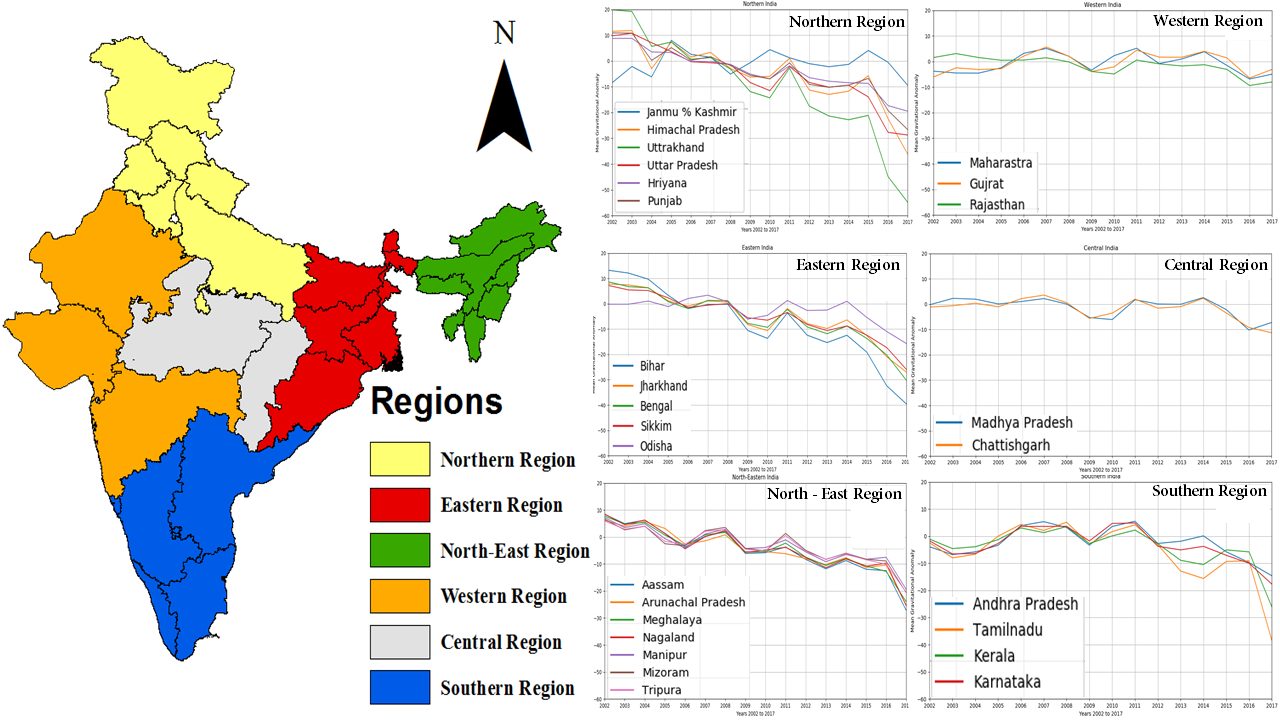
Following figure depicts all 14 major river basins of India as areas of interest. It also displays different water storage distribution over Ganga_basin as an example. Similar analysis have been carried out for rest of the river basins over the time period of 2002 -2017.
-
Permanent Service for Mean Sea Level (PSMSL) is the global data bank for long term sea level change information from tide gauges and bottom pressure recorders.
-
AVISO Mean Sea Level Data (MSL)
Global mean sea level rise is caused primarily by two factors related to global warming: the added water from melting land-based ice sheets and glaciers and the expansion of seawater as it warms. Following shows the MSL of Bay of Bengal measured from four control points over past 100 years (approx).
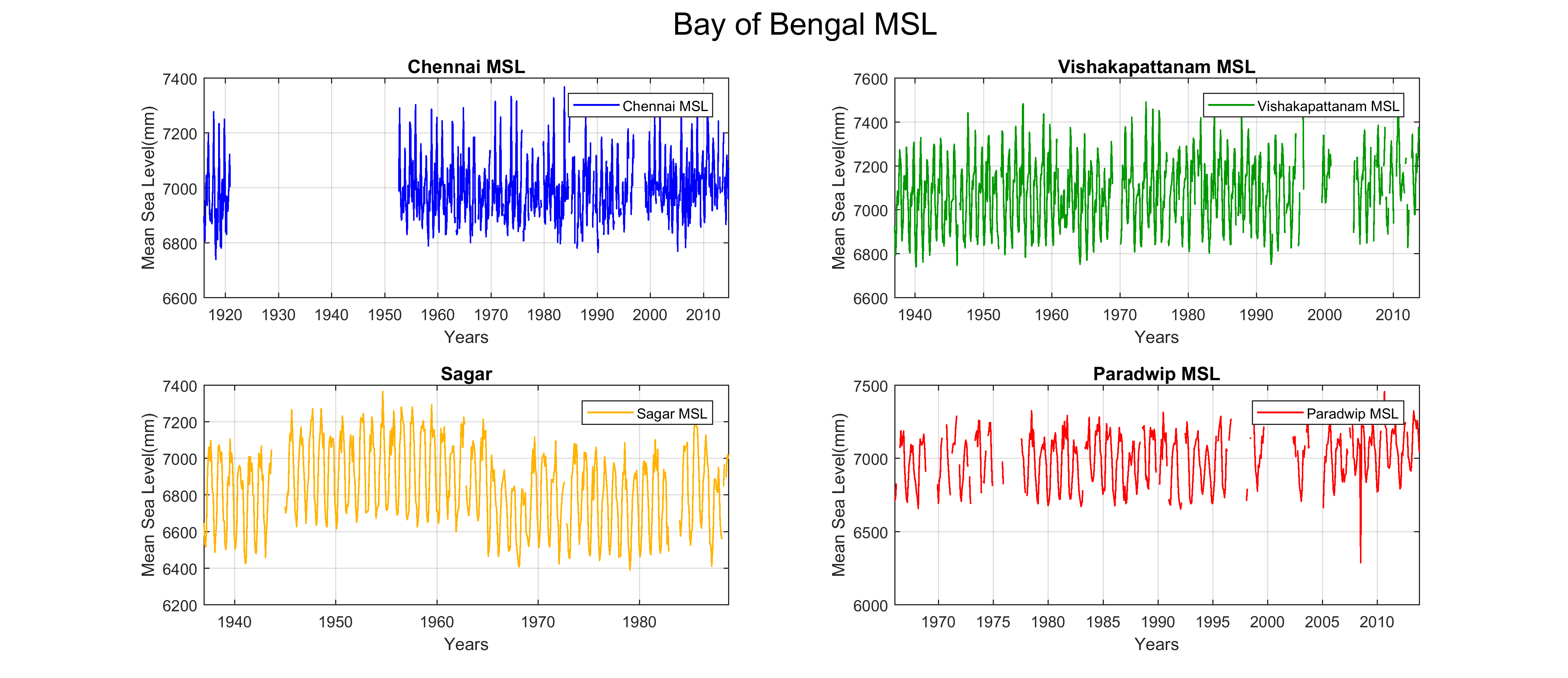
Slope of SST changes over Bay of Bengal and Mediterranean Sea.
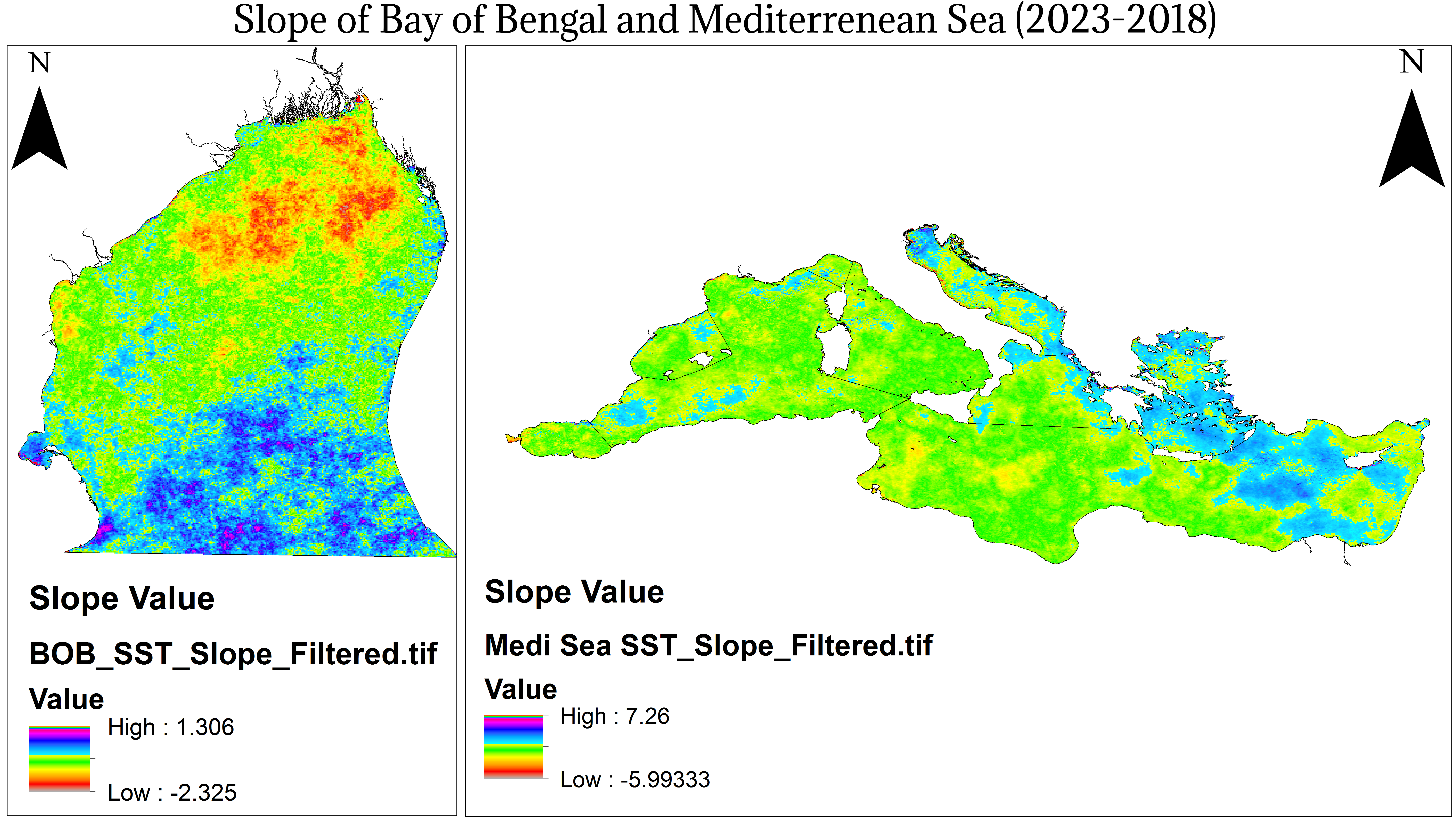
Ghosh, Arka, Anirban Mukhopadhyay, Niloy Pramanick, Soubhik Biswas, Debashis Mitra, and Tuhin Ghosh. "Interannual and intraannual comparative study of sea surface temperature distribution over the Bay of Bengal, the Arabian Sea, and the Mediterranean Sea within the time frame of 2003–18." In Disaster Resilience and Sustainability, Elsevier, 2021.
- Built a Spatial Decision Support System (SDSS) to provide a real-time dynamic computation of relative drought vulnerability index (RDVI) for selected areas of interest in India affected by by Climate Change.
-
Drought analysis is to be carried out with drought indices like the
- Standardized Precipitation Index (SPI)
- Temperature Condition Index (TCI)
- Vegetation Condition Index (VCI)
-
Mann-Kendall Test and Sen Slope Estimator was used for in-depth analysis of daily rainfall data over 115 years (1901-2015).
Screenshots of Spatial Decision Support System (SDSS)
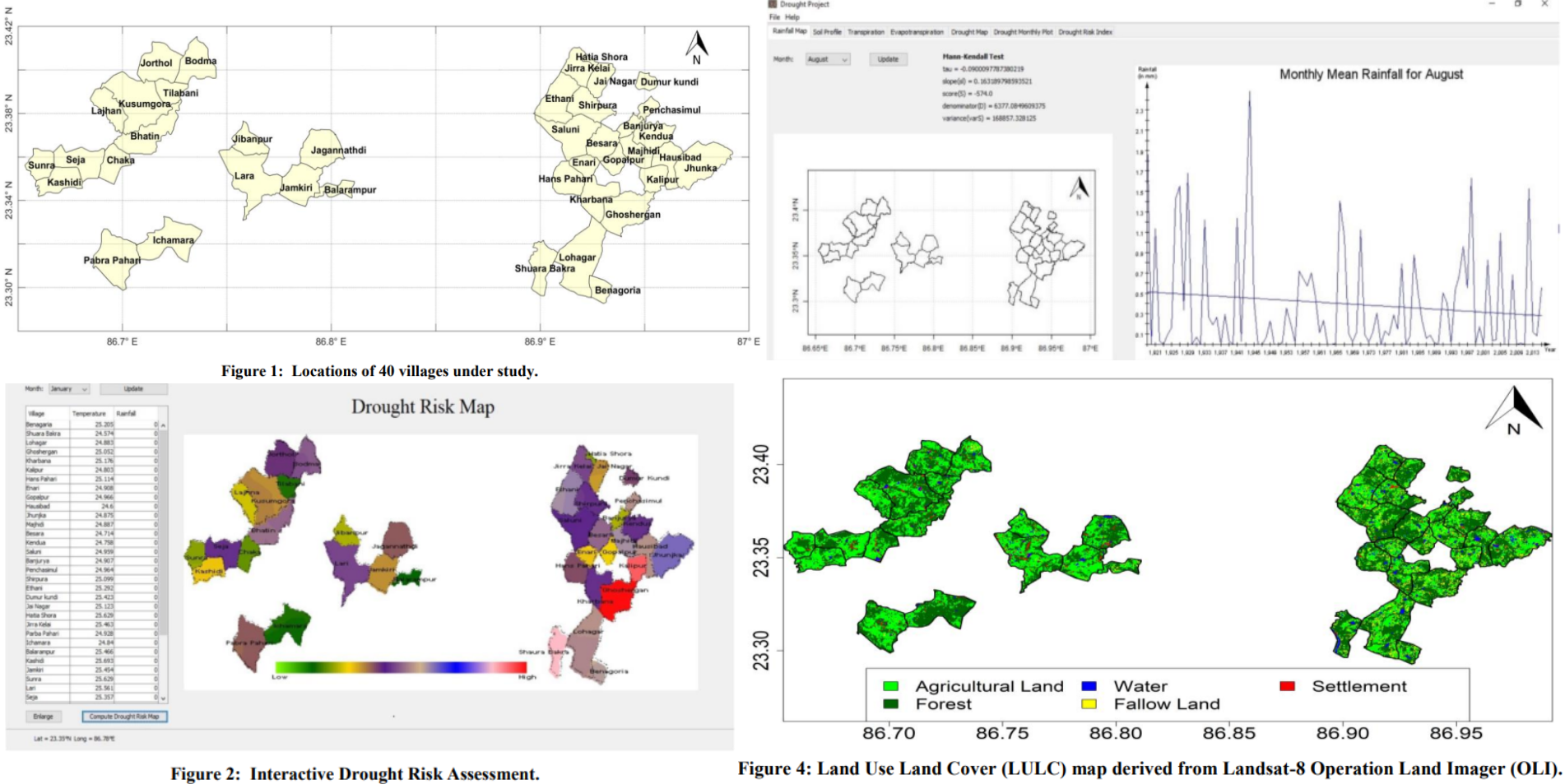
Soubhik Biswas, Ghosh, Arka, Niloy Pramanick, Anirban Mukhopadhyay and Sugata Hazra.. "Spatial Decision Support System for Climate Change Impact Assessment in> Selected Blocks of Purulia and Bankura." VayuMandal Publication, Vol 46, Issue 2, Indian Meteorological Society (IMS), 2020.
- Comparative analysis of Canadian Ice Service ice charts to characterize the temporal and spatial variability of landfast sea ice (or fast ice) surrounding Hudson Bay from 2000 to 2019.
-
Accessing geospatial raster data i.e.,
precipitationrepresented innetcdfandgeotiffformat throughxarrayto analysis them and plot stunning visalisation using matplotlib and seaborn to potray the knowledge behind those satellite raster images. -
I extracted daily data, find monthly totals, find spatial average of precipitation in a given domain, plot the results, and save the outputs as netcdf files
- Gridded precipitation data (from CPC)
- CPC Unified Gauge-Based Analysis of Daily Precipitation over CONUSlink
Used the following python packages to extratc information
- numpy
- pandas
- geopandas
- xarray
- rasterio
- rioxarray
- netcdf5
- shapely
- Check out the jupyter notebook
Query - List all the 30 meters tall residentials in Munich where average terrain elevation less than 550 meters and average land surface temperature is over 300K, given the following data.
NOTE - Provided that one dont know (or minimally) any required domain knowledge reagrding the geospatial satellite data or database technology.
- Vector Data (Munich's 25 distrcts and 105 sub-districts)
- OpenStreetMap Buildings Data
- 3DCityGML LOD2 Buildings Data
- 5 Types of Raster data
Using our developed novel Virtual Knowledge Graph (VKG) framework OntoRaster, we integrate and query the combined data without writing any ad-hoc script (in python or R) to access the different disparate formated geospatial data with minimal amount domain knowledge.
- OntoRaster can be applied to any arbritary geospatial data inclding the aforementioned data but limited to.
Here one can see the RasSPARQL queries in action.
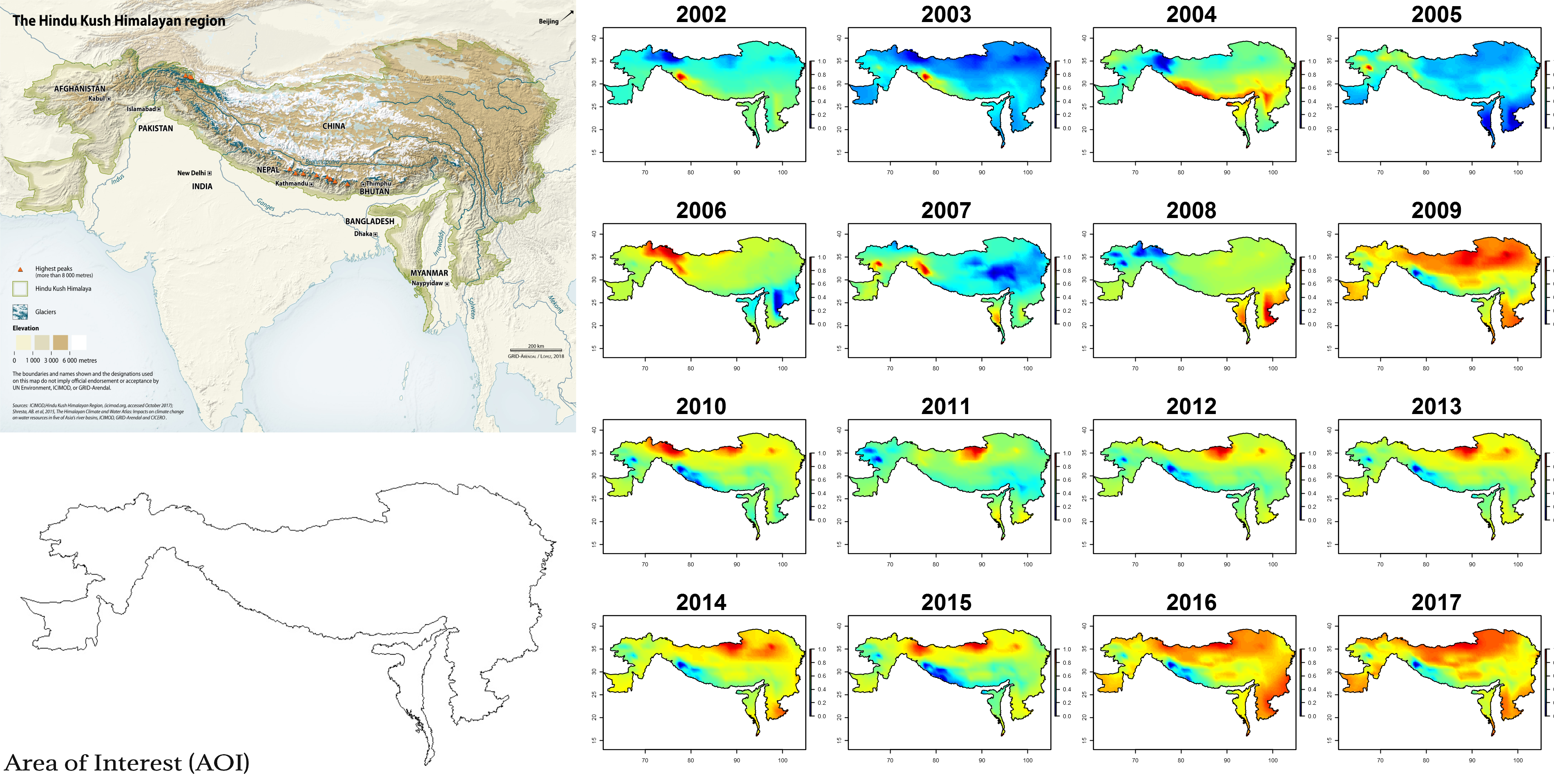
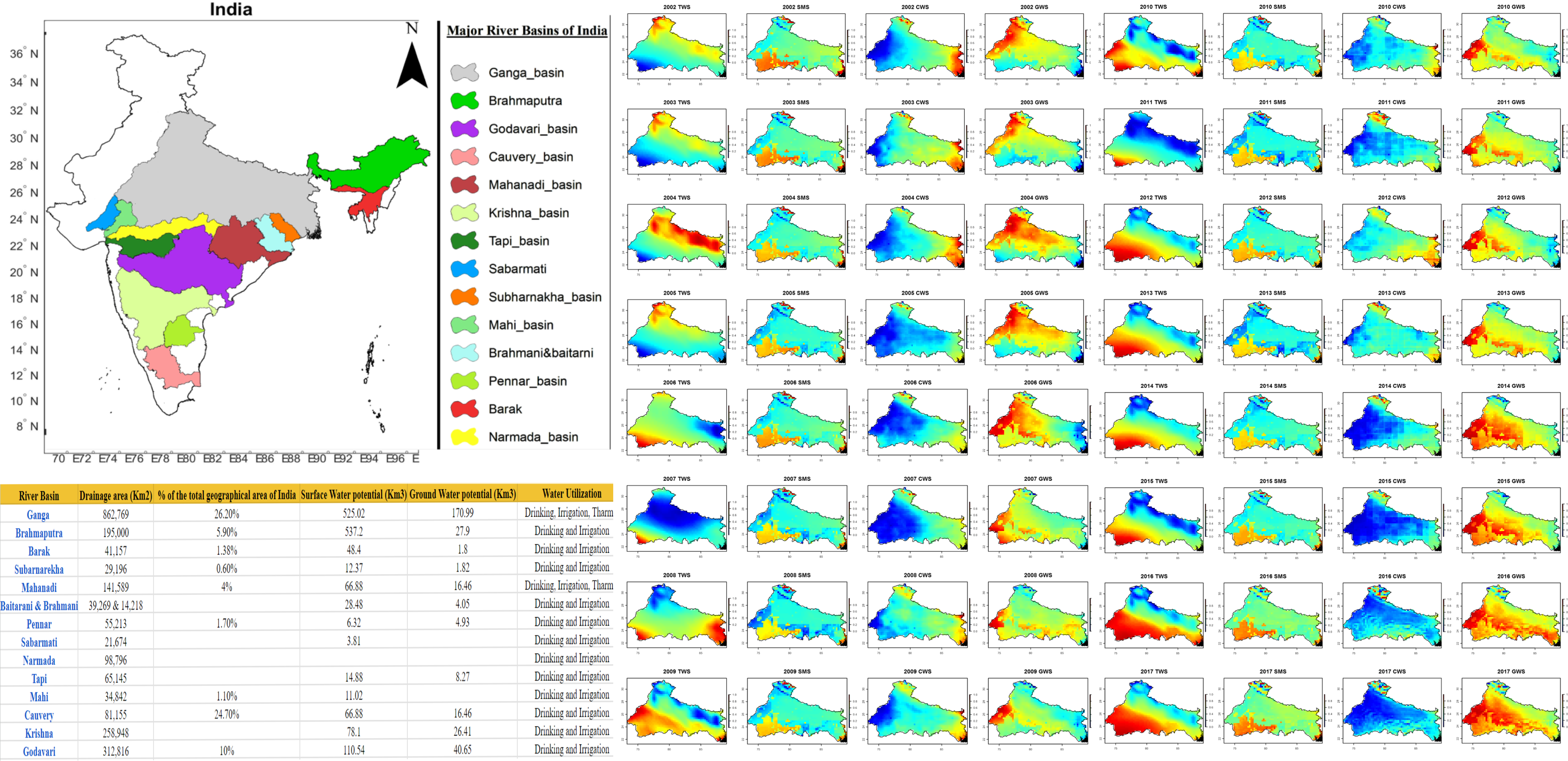
.png)
